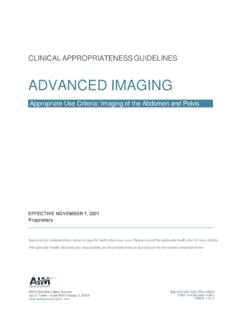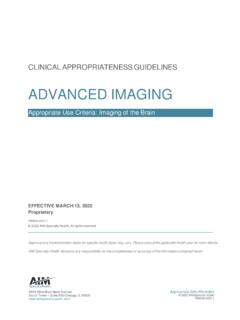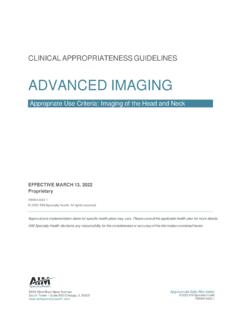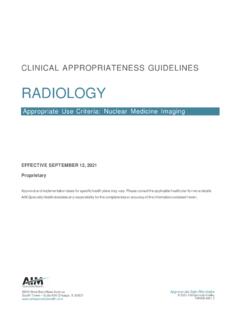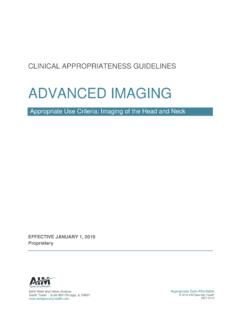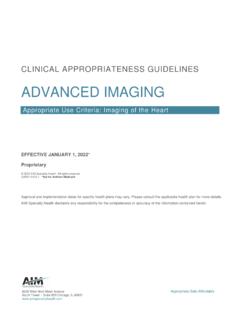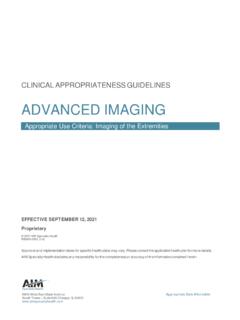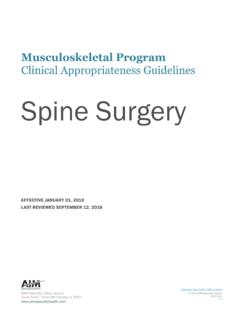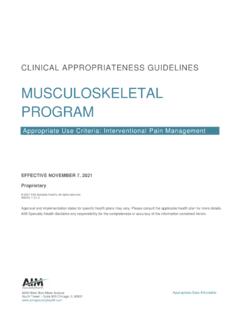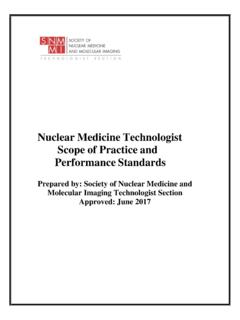Transcription of ADVANCED IMAGING - aimspecialtyhealth.com
1 CLINICAL APPROPRIATENESS GUIDELINES. ADVANCED IMAGING . Appropriate Use Criteria: Vascular IMAGING EFFECTIVE MARCH 9, 2019. Proprietary 8600 West Bryn Mawr Avenue South Tower Suite 800 Chicago, IL 60631 2017 2019 AIM Specialty Health 2057-0319. Vascular IMAGING Table of Contents Description and Application of the General Clinical Guideline ..5. Clinical Appropriateness Framework .. 5. Simultaneous Ordering of Multiple Diagnostic or Therapeutic Interventions .. 5. Repeat Diagnostic Intervention .. 5. Repeat Therapeutic Intervention .. 6. History .. 6. Vascular IMAGING ..7. General Information/Overview .. 7. Scope ..7. Technology Considerations ..7. Clinical Indications ..9. General Vascular .. 9. Congenital or developmental vascular anomalies ..9. Traumatic vascular Tumor ..9. Vasculitis .. 10. Procedure-related IMAGING .. 10. Procedure-related IMAGING .. 10. Brain, Head and Neck .. 11. Aneurysm intracranial .. 11. Arterial thromboembolic disease .. 12. Arteriovenous malformation or arteriovenous fistula.
2 12. Carotid aneurysm or dissection .. 12. Carotid stenosis or 12. Cerebrovascular accident or transient ischemic attack .. 13. Dissection intracranial .. 13. Fibromuscular dysplasia .. 13. Hematoma .. 13. Hemorrhage intracranial or subarachnoid .. 13. Horner's syndrome .. 13. Pulsatile tinnitus .. 14. Stenosis or occlusion intracranial arteries .. 14. Trigeminal neuralgia .. 14. Venous thrombosis or compression extracranial .. 14. Venous thrombosis or compression intracranial .. 14. Vertebrobasilar aneurysm or dissection .. 15. Vertebrobasilar stenosis or occlusion .. 15. Copyright 2019. AIM Specialty Health. All Rights Reserved. 2. Vascular IMAGING 15. Aortic aneurysm or dissection .. 15. Atheromatous disease (Adult only) .. 16. Pulmonary embolism .. 16. Other vascular indications 18. Abdomen and Pelvis .. 18. Aneurysm of the abdominal aorta .. 18. Aneurysm of the iliac vessels .. 19. Arteriovenous malformation or fistula .. 20. Dissection of the abdominal aorta or branch vessel.
3 20. Hematoma/hemorrhage abdominal aorta and/or branch vessel .. 20. Mesenteric ischemia .. 20. Portal hypertension .. 21. Pseudoaneurysm abdominal aorta or branch vessel .. 21. Renal artery stenosis .. 21. Stenosis or occlusion of the abdominal aorta or branch vessels .. 21. Unexplained blood loss in the abdomen or pelvis .. 21. Venous thrombosis or occlusion .. 22. Visceral artery aneurysm .. 22. Upper Extremity .. 22. Steno-occlusive disease .. 22. Other vascular indications upper 22. Lower Extremity .. 23. Peripheral arterial disease lower extremity .. 23. Other vascular indications lower extremity .. 23. MR Angiography of the Spinal Canal .. 24. MR angiography of the spinal canal .. 24. References .. 24. Codes .. 27. History .. 28. Copyright 2019. AIM Specialty Health. All Rights Reserved. 3. Vascular IMAGING Description and Application of the Guidelines The AIM Clinical Appropriateness Guidelines (hereinafter the AIM Clinical Appropriateness Guidelines or the Guidelines ) are designed to assist providers in making the most appropriate treatment decision for a specific clinical condition for an individual.
4 As used by AIM, the Guidelines establish objective and evidence-based criteria for medical necessity determinations where possible. In the process, multiple functions are accomplished: To establish criteria for when services are medically necessary To assist the practitioner as an educational tool To encourage standardization of medical practice patterns To curtail the performance of inappropriate and/or duplicate services To advocate for patient safety concerns To enhance the quality of health care To promote the most efficient and cost-effective use of services The AIM guideline development process complies with applicable accreditation standards, including the requirement that the Guidelines be developed with involvement from appropriate providers with current clinical expertise relevant to the Guidelines under review and be based on the most up-to-date clinical principles and best practices. Relevant citations are included in the References section attached to each Guideline.
5 AIM reviews all of its Guidelines at least annually. AIM makes its Guidelines publicly available on its website twenty-four hours a day, seven days a week. Copies of the AIM Clinical Appropriateness Guidelines are also available upon oral or written request. Although the Guidelines are publicly-available, AIM considers the Guidelines to be important, proprietary information of AIM, which cannot be sold, assigned, leased, licensed, reproduced or distributed without the written consent of AIM. AIM applies objective and evidence-based criteria, and takes individual circumstances and the local delivery system into account when determining the medical appropriateness of health care services. The AIM Guidelines are just guidelines for the provision of specialty health services. These criteria are designed to guide both providers and reviewers to the most appropriate services based on a patient's unique circumstances. In all cases, clinical judgment consistent with the standards of good medical practice should be used when applying the Guidelines.
6 Guideline determinations are made based on the information provided at the time of the request. It is expected that medical necessity decisions may change as new information is provided or based on unique aspects of the patient's condition. The treating clinician has final authority and responsibility for treatment decisions regarding the care of the patient and for justifying and demonstrating the existence of medical necessity for the requested service. The Guidelines are not a substitute for the experience and judgment of a physician or other health care professionals. Any clinician seeking to apply or consult the Guidelines is expected to use independent medical judgment in the context of individual clinical circumstances to determine any patient's care or treatment. The Guidelines do not address coverage, benefit or other plan specific issues. Applicable federal and state coverage mandates take precedence over these clinical guidelines. If requested by a health plan, AIM will review requests based on health plan medical policy/guidelines in lieu of the AIM Guidelines.
7 The Guidelines may also be used by the health plan or by AIM for purposes of provider education, or to review the medical necessity of services by any provider who has been notified of the need for medical necessity review, due to billing practices or claims that are not consistent with other providers in terms of frequency or some other manner. Copyright 2019. AIM Specialty Health. All Rights Reserved. 4. Vascular IMAGING General Clinical Guideline Clinical Appropriateness Framework Critical to any finding of clinical appropriateness under the guidelines for a specific diagnostic or therapeutic intervention are the following elements: Prior to any intervention, it is essential that the clinician confirm the diagnosis or establish its pretest likelihood based on a complete evaluation of the patient. This includes a history and physical examination and, where applicable, a review of relevant laboratory studies, diagnostic testing, and response to prior therapeutic intervention. The anticipated benefit of the recommended intervention should outweigh any potential harms that may result (net benefit).
8 Current literature and/or standards of medical practice should support that the recommended intervention offers the greatest net benefit among competing alternatives. Based on the clinical evaluation, current literature, and standards of medical practice, there exists a reasonable likelihood that the intervention will change management and/or lead to an improved outcome for the patient. If these elements are not established with respect to a given request, the determination of appropriateness will most likely require a peer-to-peer conversation to understand the individual and unique facts that would supersede the requirements set forth above. During the peer-to-peer conversation, factors such as patient acuity and setting of service may also be taken into account. Simultaneous Ordering of Multiple Diagnostic or Therapeutic Interventions Requests for multiple diagnostic or therapeutic interventions at the same time will often require a peer-to- peer conversation to understand the individual circumstances that support the medical necessity of performing all interventions simultaneously.
9 This is based on the fact that appropriateness of additional intervention is often dependent on the outcome of the initial intervention. Additionally, either of the following may apply: Current literature and/or standards of medical practice support that one of the requested diagnostic or therapeutic interventions is more appropriate in the clinical situation presented; or One of the diagnostic or therapeutic interventions requested is more likely to improve patient outcomes based on current literature and/or standards of medical practice. Repeat Diagnostic Intervention In general, repeated testing of the same anatomic location for the same indication should be limited to evaluation following an intervention, or when there is a change in clinical status such that additional testing is required to determine next steps in management. At times, it may be necessary to repeat a test using different techniques or protocols to clarify a finding or result of the original study. Repeated testing for the same indication using the same or similar technology may be subject to additional review or require peer-to-peer conversation in the following scenarios: Repeated diagnostic testing at the same facility due to technical issues Repeated diagnostic testing requested at a different facility due to provider preference or quality concerns Repeated diagnostic testing of the same anatomic area based on persistent symptoms with no clinical change, treatment, or intervention since the previous study Repeated diagnostic testing of the same anatomic area by different providers for the same member over a short period of time Copyright 2019.
10 AIM Specialty Health. All Rights Reserved. 5. Vascular IMAGING Repeat Therapeutic Intervention In general, repeated therapeutic intervention in the same anatomic area is considered appropriate when the prior intervention proved effective or beneficial and the expected duration of relief has lapsed. A. repeat intervention requested prior to the expected duration of relief is not appropriate unless it can be confirmed that the prior intervention was never administered. History Status Date Action Revised 03/09/2019 Retitled Pretest Requirements to Clinical Appropriateness Framework to summarize the components of a decision to pursue diagnostic testing. To expand applicability beyond diagnostic IMAGING , retitled Ordering of Multiple Studies to Simultaneous Ordering of Multiple Diagnostic or Therapeutic Interventions and replaced IMAGING -specific terms with diagnostic or therapeutic intervention. Repeated IMAGING split into two subsections, repeat diagnostic intervention and repeat therapeutic intervention.
